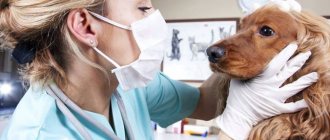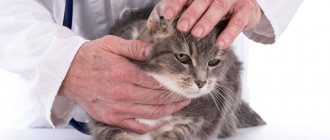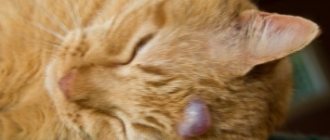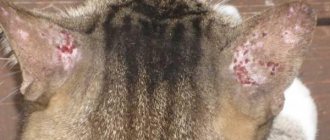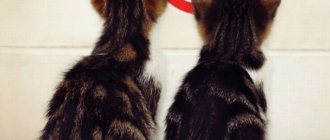Diabetes mellitus in cats is a common and fairly common endocrine disease; in this disease, the animal’s body is not able to properly monitor the amount of glucose in the blood and its metabolism. At the same time, insulin production decreases or tissue cells become resistant to its action. And partial or complete insulin deficiency is the cause of persistent hyperglycemia, which characterizes feline diabetes mellitus.
In general, a cat is a different animal from a dog and is more sensitive to stress, which can cause blood glucose levels to rise, although this does not mean that the cat necessarily has diabetes, but only temporary hyperglycemia. When the cat calms down, this phenomenon goes away. Therefore, sometimes when taking blood in a clinic, where every pet can be very worried, sugar may turn out to be elevated, and such a case always requires further clarification.
Causes of diabetes in cats
Any cat can get diabetes, regardless of breed or gender. Data have been established and published in the literature according to which castrated cats are approximately 2 times more likely to develop diabetes mellitus than sterilized cats. This is argued by the fact that cats have a higher risk of developing obesity, higher insulin concentrations and lower sensitivity to it. Insulin is a special hormone that is secreted by the pancreas. Once in the blood, it transfers glucose to the organs and tissues of the body, and each cell of the body thus receives nutrition and energy. But the disease itself develops, manifests itself and proceeds in the same way in both sexes, and diabetes mellitus in cats has absolutely the same consequences and complications as in cats. And obesity is in any case the main predisposing factor.
What you need to know about the disease
Feline diabetes is a disease similar to humans. It has similar causes and clinical picture.
Why diabetes is dangerous
Without timely treatment, the disease leads to sudden weight loss, dehydration, problems with motor function, coma and death. The danger of the pathology is that it is detected late. By the time cats are diagnosed, they are usually already severely insulin dependent.
Risk group
Animals suffering from obesity and inflammation of the pancreas are at particular risk. There is no clearly defined age category for cats with diabetes. Although it has been noted that most often the disease occurs in middle-aged and elderly pets. The disease is more common in cats than in cats.
Types of diabetes in cats
Animals have a classification of diabetes mellitus, but in cats it is more conditional than in humans. Since in most representatives of this species it is impossible to accurately determine the type of this disease, insulin administration is most often used for treatment, regardless of the reasons for the development of the pathology. However, there are three types of diabetes mellitus in cats:
- insulin-dependent diabetes mellitus (type I)
- non-insulin-dependent diabetes mellitus (type II)
- secondary diabetes (type III)
The first type of diabetes mellitus can occur at any age and requires regular lifelong use of insulin, otherwise the animal will die. Often cats with this type of diabetes are thin, and sometimes complications such as ketoacidosis occur.
More diabetic patients have type 2 diabetes. They are usually over 7 years of age, overweight or normal weight, with decreased sensitivity to insulin. Without insulin therapy or skipping an injection, these cats do not die and usually do not develop ketoacidosis. But to improve the quality of life and reduce the negative impact of excess glucose on the organs of the body, such patients can also be treated with an insulin drug.
The third type includes diabetes provoked by a primary disease - these are pathologies that directly affect the pancreas: pancreatitis, neoplasm (usually adenocarcinoma of the gland), endocrinopathies: hyperadrenocorticism, hyperthyroidism, acromegaly. The introduction of some diabetogenic drugs can cause the development of the disease - glucocorticoids, progesterone. When the underlying cause is addressed, secondary diabetes may resolve, and sometimes cats also require lifelong insulin therapy, but insulin doses are often required quite high due to the development of resistance to the hormonal drug administered.
Diabetes mellitus in a sick cat may be uncomplicated, with no increase in ketone bodies in the blood (ketonemia), no metabolic acidosis, and, accordingly, no coma or stupor. This form can also be called transient. And the lack of timely diagnosis or necessary treatment will lead to a complicated form of the disease - ketoacidotic diabetes mellitus or hyperosmolar non-ketoacidotic diabetic syndrome. The latter is rare.
Causes of the disease
Diabetes, which 20 years ago was considered an exclusively human disease, today is not uncommon among our smaller brothers. The disease develops because specific cells in the pancreas produce little or no insulin.
Factors that provoke the occurrence of pathology include:
- Unbalanced diet, vitamin deficiency.
- Diseases of the digestive system.
- Chronic pathologies of the gallbladder, kidneys, liver.
- Overeating, excess body weight. Veterinarians usually understand this as a weight that is 1.5-2 kilograms more than normal.
- Genetic predisposition. Taking this fact into account, breeders do not use individuals diagnosed with diabetes in breeding work.
- Viruses, infections that weaken the animal’s immunity.
- Long-term use of hormones, including contraceptives.
- Psycho-emotional stress.
There are first and second types of diabetes mellitus. In the first case, insulin-dependent pathology develops. Destructive changes occurring in the pancreas provoke the breakdown of cells responsible for the production of insulin. Fortunately, this type of disease occurs in rare cases among our smaller brothers.
The second type of diabetes is characterized by the fact that beta cells produce insulin, but in very small quantities for the normal functioning of organs and systems. Occurs in 70-80% of all cases. The disease does not require the use of hormones in therapy, but specific treatment is necessary. Otherwise, complications in the form of insulin dependence, characteristic of the first type, cannot be avoided.
Symptoms of diabetes in cats
Diabetes mellitus in cats will have signs and symptoms depending on the form of the disease. But, of course, the most common symptom is increased thirst (polydipsia) and, as a result, polyuria appears. At the same time, more urine is produced, and the cat begins to urinate more often and more volume, and the urine itself becomes lighter, more transparent and contains glucose, so sometimes the first sign that the owner notices is sticky marks from the pet’s paws on the floor or other surfaces in the apartment. Also, with uncomplicated diabetes, there may be an increase in appetite (polyphagia). But, despite an increased or normal appetite, the animal begins to lose weight.
If the owner does not attach importance to these manifestations, then the pet’s condition will gradually worsen. This generally occurs over a period of a couple of weeks to many months, and can take a year in some cats. Then weakness, lethargy, vomiting appear, diarrhea, changes in gait, and unsteadiness are possible.
Complications
Diabetes mellitus can cause the following complications in animals::
- ketoacidosis;
- diabetic neuropathy;
- hypoglycemia;
- diabetic angiopathy;
- retinopathy;
- nephropathy;
- trophic ulcers.
Without help, your cat may develop diabetic coma.
Ketoacidosis
This condition is caused by a high concentration of sugar in the animal's blood, which causes the breakdown of fats to produce a large number of ketone bodies. This complication causes the cat to experience wild thirst. Due to intoxication, the heart rhythm is disturbed and shortness of breath appears. Without assistance, the animal may die.
Diabetic neuropathy
High blood sugar levels in a cat cause damage to nerve endings, most often in the limbs. The animal begins to tread poorly on its paws, its gait becomes uncertain and wobbling.
© shutterstock
Hypoglycemia
With a strong decrease in blood sugar levels, hypoglycemia, a diabetic coma may occur. The cat begins to experience anxiety, muscle tremors, and possible loss of consciousness.
Diabetic angiopathy
In this condition, vascular permeability increases, which leads to the development of coronary heart disease and malnutrition of the limbs. Blood clots may appear.
Retinopathy
High sugar levels also affect your cat's eyes. The retina begins to deteriorate and sometimes detaches. After some time, complete blindness occurs.
Nephropathy
Diabetes mellitus causes kidney damage, which ultimately leads to chronic organ failure.
Trophic ulcers
Due to impaired blood supply to the hind and forelimbs, trophic ulcers begin to appear in the last stage of the disease.
Diagnosis of diabetes mellitus in cats
The pet owner himself may suspect such a disease, but only a veterinarian can confirm the diagnosis. Unfortunately, in most cases, the animal does not arrive at the clinic at the primary stage of the disease. And although in such a situation, diabetes mellitus in cats has quite characteristic symptoms, it is imperative to carry out a comprehensive diagnosis, otherwise it is impossible to identify all the complications that have developed and stabilize the patient by providing proper assistance.
First of all, the doctor will conduct a clinical examination of the patient. In this case, it is possible to identify changes in the coat: dandruff, dull wool, stuck together in tufts; as well as obesity or exhaustion, dehydration, hypothermia, depression, muscle wasting, plantigrade gait. Next, in all cases, blood is taken for biochemical, general clinical and thyroid hormone analysis, a urine test is prescribed, ultrasound diagnostics of the abdominal organs is performed, and, if necessary, a cardiological examination. The results of all these studies will allow us to determine the type of diabetes and choose the appropriate treatment for each individual patient.
What medications are prescribed?
Medications for the treatment of diabetes mellitus in cats are very diverse. If the second or third type is detected, medications are required to gradually reduce the concentration of sugar in the blood:
- Metformin;
- Miglitol;
- Gliquidone;
- Glipizide.
In the case of type 1 diabetes, insulin medications are required. There are special types of medications for cats. Some forms of insulin made for humans are also suitable for cats:
- Actrapid, Monodar – short effect;
- Lente, Protafan – medium action;
- Glargine, Detemir, Protamycin PZI – long-term effect.
Before injection, it is important to check the animal’s body’s reaction to the drug. The dose for each animal is selected taking into account the stage of the disease, age and characteristics of the body. Accordingly, there is no single treatment regimen applicable to all cats. Insulin needles are very short, so it will not be possible to cause harm or discomfort to the animal, that is, you can inject yourself. The injections must be administered subcutaneously at the withers, and strictly in compliance with the dosage calculated by the veterinarian.
Along with the injections, you should monitor your sugar levels using special test strips and a glucometer. This allows you to make timely adjustments and increase the effectiveness of therapy.
Treatment of diabetes mellitus in cats
After confirmation of the diagnosis, the treatment plan is already determined by the veterinary endocrinologist. Of course, diabetes mellitus in cats is treated depending on the type of disease. In the case of a complicated form of the disease, hospitalization of the animal is necessary, and in a hospital setting, primary rather intensive therapy is carried out - infusion of drugs and insulin injections, and a special scheme of frequent administration of short-acting insulin is used, and the dose is low, necessary only to relieve ketoacidosis. And only after the condition improves and the level of ketones in the blood normalizes, the doctor selects the required type of insulin, the active substance of which may have a different duration of action. For these purposes, the doctor usually draws up a so-called sugar curve. Whatever insulin is used, cats require insulin injections every 12 hours (there are no daily insulins available for cats yet). The necessary symptomatic treatment is also prescribed according to the identified concomitant pathologies.
If uncomplicated diabetes mellitus is present, then, depending on the expected type of diabetes, treatment with diet therapy in combination with insulin or oral medications is chosen, but most medical hypoglycemic tablet forms are not used in cats due to their hepatotoxicity and short-term effect. And if a primary disease is identified, then the necessary drugs are selected to correct it.
Nutrition is a major part of therapy for sick, overweight animals. Reducing body weight is considered one of the main conditions necessary for a positive result in the treatment of diabetes, due to the fact that with a decrease in the volume of adipose tissue in the body, the sensitivity to insulin increases, both administered - exogenous, and produced in the animal - endogenous. Weight loss should be gradual - within 1-2% of body weight per week. To do this, the volume of feeding is reduced and the necessary diet is selected. Ready-made industrial feeds for diabetics are often used if there are no contraindications due to concomitant diseases. If insulin therapy is carried out, then the optimal feeding regimen is two times a day - necessarily after the administration of insulin, plus additional feeding is possible at the peak of the drug's effect (if one is chosen). If the cat has been accustomed to frequent split feedings, then the diet does not require changes. In overly thin cats, high-calorie foods are used at the first stage of diet therapy, again, if there are no contraindications to them. Accordingly, there is no single feeding standard; the nutrition plan is selected individually for each animal, taking into account several factors. With proper treatment, remission of the disease is possible in cats, even if insulin has been used for several months, but diabetogenic drugs should not be used and it is important to try to avoid stress so as not to provoke a relapse.
How is therapy carried out?
When diabetes mellitus is detected in cats, treatment can be quite long and is usually combined. Therapy involves eliminating the factors and symptoms causing the disorder. A prerequisite is the normalization of the animal’s body weight. For this purpose, special dietary foods and a low-carbohydrate diet are used, and insulin-containing medications can also be used.
First aid rules
When a cat is prescribed insulin, it must be injected on a set schedule. Delaying even one injection will disrupt the schedule, which may result in hypoglycemia (excess insulin). The sugar concentration will drop to critical levels, and the cat will show symptoms:
- weakness;
- apathy;
- impaired coordination;
- convulsions;
- coma.
The main thing is to prevent a state of coma, since cats rarely return from it. If you notice these symptoms, it is important to check your sugar levels. If it is critically small, give the animal food with fast carbohydrates. If your cat refuses to eat on his own, pour sugar syrup into his mouth or soak gauze in it and wipe his gums. If the animal does fall into a coma, you should not give it anything to prevent it from choking. It is important to take your cat to the clinic urgently.
Basic therapy
Treatment of cats with diabetes is selected taking into account the form of the disease. If it is the first type, short-acting insulin injections will be needed, and with the second type, instead of hormonal injections, drugs to lower sugar levels or injections of medium or long-term action are required.
- Drugs to reduce sugar. These are mainly tablets prescribed for types 2 and 3 diabetes. The medicine reduces the concentration of sugar to normal levels and eliminates the adverse effects of sugar on all systems and organs. The general condition of the animal is rapidly improving. All medications should be given only as prescribed by a veterinarian, as many have side effects.
- Hormonal injections. The difficulty with using insulin is that it is always difficult to choose a dosage that will help effectively treat the disease. This requires regular glucose monitoring after each new dose. Accordingly, studies are carried out in stationary conditions. The doctor records the time, calculates the dosage and determines the duration of action of insulin injections. Taking into account these data, a scheme for the use of insulin is formed in each individual case.
- Correct diet. Normal nutrition for diabetes involves following a diet. A veterinarian should tell you what to feed a cat with diabetes. The main thing is that it is based on animal proteins. At the same time, the volume of carbohydrates is minimized. It is also important to find food without potatoes, cereals, sweeteners and sugar. Meals should be multiple - 5-6 times a day, and always in small portions.
Prognosis for diabetes mellitus in cats
Forecasts depend on the timeliness of treatment, the volume of changes and the form of the flow. The initial stage of diabetes treatment is always difficult for the owner, requiring additional time, training in measuring blood glucose, administering and handling insulin, changes in personal schedule, frequent follow-up examinations in the clinic and close cooperation with a veterinary endocrinologist. But it is worth it, and the result is worth the investment, since cats with diabetes can live quite a long time, including the average life expectancy of a non-diabetic cat. Complicated diabetes, in the presence of a severe condition - up to coma, has a cautious prognosis, and in some severe cases, unfavorable. But it is possible to stabilize a patient in a coma, and this has been done successfully.
Nutrition rules and food selection
Food for cats and diabetic cats must correspond to the type of disease and the amount of insulin injected. A cat with diabetes needs to be fed little by little and often. Approximately 4–5 feedings per day. For a cat with diabetes, it is important to eat on a schedule.
Cat food for diabetics should not contain soy or preservatives. Fifty percent of the food for cats with diabetes should contain: meat, poultry, fish or offal. Twenty-five percent of the diet should include dairy ingredients. The remaining twenty-five are cooked vegetables.
There is a large selection of good food for cats with diabetes on the pet supply market. For example, Royal Canin or Purina diabetic series. Wet food is more suitable for the diet. These foods help prevent obesity.
Clinical case of treatment of diabetes mellitus in a cat
An almost 12-year-old cat, Ryzhik, was admitted to Pride with a complaint of weight loss for 3-4 weeks, periodic vomiting, decreased appetite, increased thirst and frequent urination. The cat was examined - blood and urine tests, abdominal ultrasound, and tonometry were done. Based on the results of research, an endocrinologist diagnosed CKD and diabetes mellitus complicated by ketoacidosis.
The patient was admitted to Pride's intensive care unit to stabilize his condition. A course of drips and insulin therapy were carried out according to a special scheme to eliminate ketoacidosis. A week later, when Ryzhik began to feel well, the doctor selected long-acting insulin for daily administration at home, trained the housewife on measuring blood glucose and administering insulin, and prescribed therapy for kidney disease.
Within a month and a half of treatment, the cat gained 600 g of weight, began to purr again and lead a normal lifestyle.
Home monitoring
Constantly carried out by the owner to monitor blood glucose levels. If the indicators are inadequate, the doctor adjusts the treatment regimen. Measuring blood glucose levels is possible using a glucometer. In this case, a small drop of blood is enough, which is usually taken from a puncture on the surface of the ear. The level of glucose in the patient's urine is also measured using test strips, the color of which changes depending on the content of glucose and ketone bodies in the urine. For testing, it is necessary that the cat goes into a clean litter box without litter.
Also, the owner must constantly monitor the general condition of his pet, its behavior, and activity. It is important to know whether the cat eats well and how much fluid it consumes.
Timely and correct diagnosis of the disease will allow you to achieve remission and significantly improve the quality of life of your pet.
(c) Veterinary center for the treatment and rehabilitation of animals “Zoostatus”. Varshavskoe highway, 125 building 1. tel. 8 (499) 372-27-37
Disease prevention measures
Veterinarians say that almost any disease can be prevented. You can minimize the likelihood that cats will develop diabetes by:
- pay attention to creating a balanced diet;
- control the weight of your pet;
- keep your pet healthy and active;
- Do not neglect routine examinations of your cat by a veterinarian.
Separately, it is worth mentioning chronic and infectious diseases. If they are identified, do not initiate treatment for them. Eliminate manifestations of diseases in a timely manner. Remember about the likelihood of developing secondary diabetes mellitus. If the pathology requires the use of steroids, reduce their amount to a minimum (especially if the pet is obese). And always follow the recommendations for keeping a pet, received in consultation with your veterinarian!
